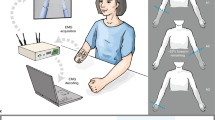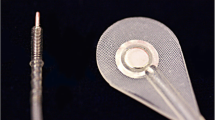Abstract
Robotic manipulators can be controlled in an autonomous way with great precision and dexterity. At the same time they can be equipped with sensors capable of conveying highly precise information on the surroundings, many times superior to that of a human sensory system. However, our limited capacity of interfacing these robots with the human body makes current prosthetic systems to be perceived by the users as simple tools rather than limbs. After decades of developments, osseointegration, selective nerve transfers, and nerve electrodes for sensory feedback have all been clinically tested in humans and are opening a new gateway for implementation of novel control strategies. Here, an overview of the most promising myocontrol and myoelectric signal processing technics to pave the way to longer-term visions of true limb replacement are presented.
Access provided by Autonomous University of Puebla. Download conference paper PDF
Similar content being viewed by others
Keywords
- Prosthetic Limb
- Osseointegration
- Targeted Muscle Reinnervation (TMR)
- Motor Unit Spike Trains
- Direct Skeletal Attachment
These keywords were added by machine and not by the authors. This process is experimental and the keywords may be updated as the learning algorithm improves.
1 Introduction
With the turn of the 20th century, first truly actuated arm prosthetic systems came to the market. Though still praised for its performance [1], Bowden cable driven body powered hook has since been gradually replaced by the myoelectically (EMG) controlled powered systems. With the development of new materials and manufacturing techniques the prosthetic hardware has been considerably improved, but the basic myocontrol chain has remained the same. Following the EMG signal acquisition and conditioning, signal feature extraction is done. Features are further fed to the control system which estimates the desired actions and the mapping to the prosthetic motor commands is made. If available, the signals of the sensors of the prosthesis are finally fed back to the user and thus effectively the control loop is being closed.
For years, elements of this myocontrol chain have been modified offering different takes on extracting and estimating user’s intentions. Until recently, this evolution was mainly incremental and based on machine learning myocontrol postulates introduced in the 1970s [2]. Gradually, the laboratory based performance has been increasing, and only recently these solutions have made it to the market.
However, years of development have also yielded techniques such as osseointegration which allows direct skeletal attachments of prosthetics and moreover establishes a direct gateway for wired intramuscular recordings and nerve stimulation [3]. Targeted Muscle Reinnervation (TMR) [4] and selective nerve transfers [5] offer an access to an increased information content coming from the neural drive by fully embracing the concept of muscle as an amplifier of the nerve signal. This is done by rerouting the residual nerves of the amputated limb to the neighboring intact muscle tissue.
With these new techniques and technologies, we are experiencing a conceptual change in each of the elements of the myocontrol chain and as such novel strategies for upper limb prosthetics are being introduced. The following sections will introduce the most promising advancements in each of the myocontrol chain blocks.
2 Improvements of the Myocontrol Chain
2.1 Feature Extraction
Most commonly myocontorol interfaces treat EMG as an interferent signal (colored noise) from which a set of global features are extracted. These usually consider amplitude or spectral moments either in case of standard direct control or for identifying sets of predefined movements through pattern recognition [6].
Since the introduction of the high-density (HD) EMG sensors a new set of algorithms for the extraction of the sources of neural information have been developed. Leveraging on the high spatial sampling, using blind source separation approach an EMG deconvolution can be performed and the discharge timings of individual motor neurons responsible for muscle contractions can be obtained.
Thanks to TMR which allows formation of spatially large EMG sources, these motor unit spike trains can be robustly extracted and used as highly descriptive input features of a variety of control systems. By enabling direct interfacing to the neural information stored at the spinal cord level, these novel features are able to significantly improve performance of classic myocontrol systems [7]. Though, it should be noted that currently these efforts have been validated only in offline investigations.
2.2 Control Algorithms
Commercially available prosthetic systems have until recently been solely relying on the direct control approaches accompanied by a simple state machine which allowed articulation of different DoFs through a set of switches. Few years ago Coapt [8] has brought to the market the first pattern recognition system based on a simple classifier with eight electrode setup. This system relies on a common assumption that each motion is followed by a distinguishable EMG pattern that can be classified and as such used for control of a prosthetic system. While highly popular these systems are known to highly suffer from temporal EMG changes induced by a variety of factors such as fatigue, electrode shift, sweat, arm position or end effector load change. In addition, estimation of simultaneous motions requires significant expansion of the algorithm training data set which is not really practical.
To address some of these challenges a series of regression based approaches relating input EMG signals to targeted output kinematic/kinetic variables have been introduced. The main difference to classification is that here a continuous output value is estimated for each DoF in contrast to a discrete class. This enables an independent simultaneous and proportional control. Still these control systems remain highly sensitive to noise resulting in efficient estimation of only a couple of DoFs.
With increased number of independent EMG sources made readily available through selective nerve transfers, a hybrid solution combing the pattern recognition and regression into a single control system has been show very effective [9]. By running the two estimators in parallel the highly precise and defined single DoF motions are being handled by multiarticulated pattern recognition algorithm, while those including multiple DoFs are identified and processed by the regressor.
With the help of TMR and HD EMG a fully musculoskeletal model based control algorithm translating EMG signals to joint moments has recently been achieved [7]. Seven DoFs of the arm have been considered using 14 muscle-tendon units. The obtained joint moments were reconstructed into joint angles closely resembling those recorded from the sound limb during mirrored motions.
2.3 Mapping of the Outputs
Classifiers outputs are commonly mapped in such way so that desired gestures synchronously drive motors of the prosthesis into the predefined shape for the given class. The speed with which that is achieved is either constant or is proportional to the level of the detected contractions. On the other hand regressor outputs can also drive the motors of the estimated DoF(s) to the estimated position and as such provide more natural mapping.
Recently, an end effector simultaneous and proportional position and orientation EMG control has been shown plausible for multi joint arm system [10]. The control has been achieved by mapping the HD EMG regressor outputs to Cartesian and Polar coordinates of the tip of the prosthetic hand at the end of the 6 DoF robotic arm. While not fully intuitive, this system can be highly effective in the case of high level amputations.
2.4 Feedback Loop
Recent study has shown that in the nerves innervating the upper limbs, sensory axons outnumber motor axons by a ratio of at least 9:1 [11]. This is a strong indication that the introduction of a closed loop in the prosthetic control system is necessary in order to achieve natural control.
Broad and successful implementation of osseointegration has allowed formation of a unique bidirectional gateway which allows sensory stimulation of the nerves available in the stump [3]. By using cuff electrodes and sub motor threshold stimulation a natural sense of touch has been restored. It has been shown that this further enhanced the user acceptance of the device and allowed improved control to be achieved.
3 Conclusion
The recent advances in the restoration of upper extremity functions combined with the rapidly developing technologies and manufacturing techniques have allowed significant improvements across various parts of the myocontrol chain including introduction of highly descriptive features, powerful signal and model driven control approaches, alternative control mapping strategies and chronical nerve stimulation for establishing the natural feedback loop.
Considering the recent advancements in the control strategies, we are at the verge of developing revolutionary bidirectional myocontrol technics which can eventually bring us closer to the genuine limb replacement.
References
Schweitzer, W., Thali, M.J., Egger, D.: Case-study of a user-driven prosthetic arm design: bionic hand versus customized body-powered technology in a highly demanding work environment. J. Neuroeng. Rehabil. 15(1), 1 (2018)
Lawrence, P.D., Lin, W.-C.: Statistical decision making in the real-time control of an arm aid for the disabled. IEEE Trans. Syst. Man Cybern. (SMC-2)(1), 35–42 (1972)
Ortiz-Catalan, M., Hakansson, B., Branemark, R.: An osseointegrated human-machine gateway for long-term sensory feedback and motor control of artificial limbs. Sci. Transl. Med. 6(257), 257re6 (2014)
Kuiken, T.A., Li, G., Lock, B.A., Lipschutz, R.D., Miller, L.A., Stubblefield, K.A., Englehart, K.B.: Targeted muscle reinnervation for real-time myoelectric control of multifunction artificial arms. JAMA 301(6), 619–628 (2009)
Bergmeister, K.D., Vujaklija, I., Muceli, S., Sturma, A., Hruby, L.A., Prahm, C., Riedl, O., Salminger, S., Manzano-Szalai, K., Aman, M., Russold, M.-F., Hofer, C., Principe, J., Farina, D., Aszmann, O.C.: Broadband prosthetic interfaces: combining nerve transfers and implantable multichannel EMG technology to decode spinal motor neuron activity. Front. Neurosci. 11, 421 (2017)
Zhou, P., Lowery, M.M., Englehart, K.B., Huang, H., Li, G., Hargrove, L., Dewald, J.P.A., Kuiken, T.A.: Decoding a new neural machine interface for control of artificial limbs. J. Neurophysiol. 98(5), 2974–2982 (2007)
Farina, D., Vujaklija, I., Sartori, M., Kapelner, T., Negro, F., Jiang, N., Bergmeister, K., Andalib, A., Principe, J., Aszmann, O.C.: Man/machine interface based on the discharge timings of spinal motor neurons after targeted muscle reinnervation. Nat. Biomed. Eng. 1(2), 25 (2017)
Coapt LLC.: Coapt engineering (2016). http://www.coaptengineering.com/. Accessed 29 April 2016
Amsuess, S., Vujaklija, I., Goebel, P., Roche, A.D., Graimann, B., Aszmann, O.C., Farina, D.: Context-dependent upper limb prosthesis control for natural and robust use. IEEE Trans. Neural Syst. Rehabil. Eng. 24(7), 744–753 (2016)
Ison, M., Vujaklija, I., Whitsell, B., Farina, D., Artemiadis, P.: High-density electromyography and motor skill learning for robust long-term control of a 7-DoF robot arm. IEEE Trans. Neural Syst. Rehabil. Eng. 24(4), 1–10 (2015)
Gesslbauer, B., Hruby, L.A., Roche, A.D., Farina, D., Blumer, R., Aszmann, O.C.: Axonal components of nerves innervating the human arm. Ann. Neurol. 82(3), 396–408 (2017)
Author information
Authors and Affiliations
Corresponding author
Editor information
Editors and Affiliations
Rights and permissions
Copyright information
© 2019 Springer Nature Switzerland AG
About this paper
Cite this paper
Vujaklija, I. (2019). Novel Control Strategies for Upper Limb Prosthetics. In: Masia, L., Micera, S., Akay, M., Pons, J. (eds) Converging Clinical and Engineering Research on Neurorehabilitation III. ICNR 2018. Biosystems & Biorobotics, vol 21. Springer, Cham. https://doi.org/10.1007/978-3-030-01845-0_34
Download citation
DOI: https://doi.org/10.1007/978-3-030-01845-0_34
Published:
Publisher Name: Springer, Cham
Print ISBN: 978-3-030-01844-3
Online ISBN: 978-3-030-01845-0
eBook Packages: EngineeringEngineering (R0)




